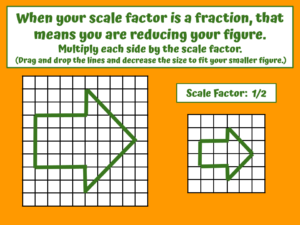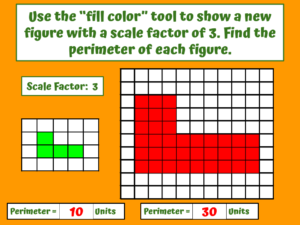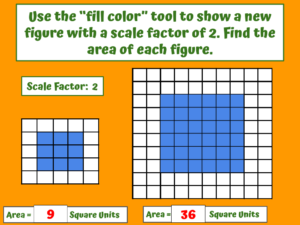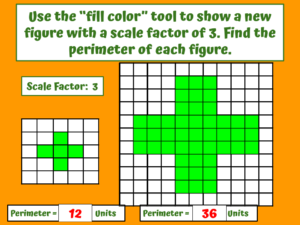How do you teach scale drawings online?
This was another dilemna I had when teaching turned virtual in 2020. I had always introduced this unit by showing my students some actual blueprints from a house I had built with my son-in-law. I wanted them to see a real-life example of how scale drawings were used. After a unit on ratios and proportions, it was the perfect segue into our geometry unit. Graph paper was passed down the rows, and students sharpened their pencils to draw various objects and pictures to scale. They had so much fun drawing and measuring. while learning vocabulary terms such as scale factor and scaled model.
Introduction on Zoom.
I had to figure out how I was going to teach this lesson digitally. There was no reason I couldn’t show my blueprints to the students on Zoom. It would be just a bit more tricky. I was sorry they weren’t able to see the plans up close, but when I told the story of how I built this house with a family member, and how we had to have these plans ready before the city would let us begin, they could make a connection in real life.
How to Make a Digital Version that’s just as much Fun.
The next trick was how to make this lesson enjoyable with Google Slides. I decided to work on making it fun. Slide number one showed the lesson title with a drawing of a cute tiger next to an identical tiger scaled down in size. Then, I used side by side tables, one with a shape for students to scale up or scale down in size. Students learned how to use the fill color feature of Google Slides to fill in the squares for their own drawings in the adjacent table. They counted the squares and determined how many to fill in using the scale factor posted. I let them choose their colors and a few creative students chose to use multiple colors to fill in their shapes. Great!
Using the Draw Line Tool
I also wanted to have them draw an arrow with diagonals, as students had done last school year with paper and pencil. The fill color feature would not work for diagonals, so I created enough lines for students to use to create their arrows. The lines could be shortened or lengthened to fit the scaled down version. It was a bit more tricky, but the struggle was perfect for problem-solving practice. Although I liked watching the students practice with the pencil and paper version, I knew the skills they were practicing digitally were also beneficial.
What Happens to Perimeter and Area when a Drawing is Scaled Up or Scaled Down?
On Google Slides, students were asked to find the perimeter or area of each figure when the drawings were complete. What happens to the perimeter when a figure is drawn to scale? What happens to the area? They discovered that when the scale factor was 2, the perimeter also increased by a factor of two. For example, a drawing with a perimeter of 14, that was scaled up by a scale factor of 2, would have a perimeter of 28. If the scale factor was 3, the perimeter would by 3 times as much or 42.
Area had a different result. I made sure they knew that the area was always in square units. They discovered that when the area of the original figure was 9 square units, the area of a figure with a scale factor of two, would be multiplied by 2 squared, or 2 to the 2nd power. The scaled up figure had an area of 36 (9 times 2 squared, or 9 times 4). A figure with an area of 3 square units and a scale factor of 3, would be multiplied by 3 to the 2nd power, or by 3 squared. The new area would be 27 (3 times 9). They could then predict perimeter and area in figures of different sizes.
Scaled Drawings – Hands on or Digital?
After teaching this lesson online, I was able to see the benefits of both methods. The kids enjoyed the digital version as well. Next year? I’ll do both!
Find this lesson in my online store: https://ampeduplearning.com/scale-drawings-digital/





